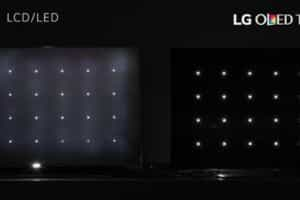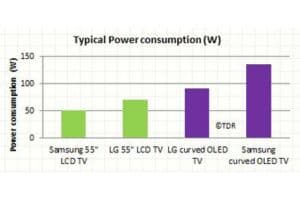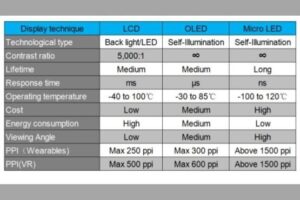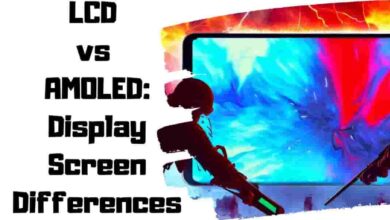OLED vs IPS -Which Display Technology to Choose

You’re probably well aware of the age-old debate between OLED and IPS display technologies, but do you truly understand what sets them apart? As a tech enthusiast, it’s essential to grasp the differences between these two leading display types. This comprehensive article dives deep into OLED and IPS displays, exploring their inner workings and comparing their performance, such as power consumption, flexibility, lifetime, visibility, colors, and refresh rates. Get ready to unveil the battle of display technologies!
By mastering your knowledge of OLED vs IPS displays, you’ll not only quench your thirst for technological understanding but also make more informed decisions when purchasing devices with these screens – smartphones, tablets, or even TVs.
So let’s embark on this illuminating journey together and discover which technology reigns supreme in vibrant visuals and captivating user experiences!
Contents
How Does An IPS LCD Display Work?
These displays are fascinating and provide excellent picture quality and viewing angles. Let’s break it down into three simple paragraphs to help you understand the magic behind these screens.

First, let’s talk about the core of an IPS (In-Plane Switching) display – its liquid crystals. Here’s what happens:
- A layer of liquid crystals is sandwiched between two glass surfaces
- The crystal molecules are aligned parallel (in-plane) to those surfaces
- When voltage is applied, the crystals rotate parallel, allowing light to pass through easily.
- This results in less interference and a clearer final image on the screen.
- The horizontal shifting ability of these crystals provides impressive viewing angles.
Now that you’ve grasped the basic concept let’s dive deeper into why IPS displays offer such accurate and consistent colors from various angles.
Unlike twisted nematic (TN) panels, which tend to have color distortion when viewed from different angles, IPS panels eliminate this issue.
This means you’ll enjoy stunning colors without any tailing effects, no matter where you sit or stand while looking at an IPS display.
Lastly, it’s important to note that IPS technology was specifically designed to overcome the limitations of TN panels. So when you choose an IPS LCD, you get a screen with superior color contrast and outstanding picture quality from all viewing angles.
Advantages Of IPS LCD Screens
You might be wondering why IPS LCD screens are all the rage; well, it’s due to their remarkable advantages, such as vivid colors, wide viewing angles, and impressive durability—making them a top contender in today’s world of visual entertainment.
Regarding display technologies, IPS LCD screens stand out for their superior performance in areas like color accuracy and consistency across the entire display.
This means that whether you’re watching movies or playing games on your device, you can expect a visually pleasing experience with true-to-life colors.
- Faster Response Times: One of the key benefits of IPS LCD screens is their improved response times compared to other display technologies. This helps reduce motion blur and ensures smoother motion in action-packed movies or gaming sessions.
- Excellent Sunlight Visibility: IPS displays offer better visibility under direct sunlight than conventional LCD technologies, making them perfect for smartphones and tablets used outdoors.
- Elimination of Touch Tailing: Unlike TN panels, there’s no touch ‘tailing’ when using an IPS screen—touch inputs are processed swiftly and precisely, greatly enhancing the overall user experience.
With all these advantages combined, it’s no wonder that professionals and enthusiasts alike are drawn to the captivating visual immersion IPS LCD screens provide.
So if you’re looking for a display technology that offers outstanding color reproduction, wide viewing angles, and consistent screen performance for an unmatched viewing experience, look no further than IPS LCD screens!
Disadvantage Of IPS LCD Screens
While IPS LCD screens boast impressive features, it’s essential to consider their drawbacks before deciding if they’re the right choice for your needs.
Lower contrast ratio: You’ll notice that IPS displays don’t quite match up to VA and AMOLED panels regarding contrast ratios. This can affect your overall image quality as black-and-white differences become less distinct.
Higher power consumption: If you’re concerned about battery life in portable devices, remember that IPS screens typically use more power than TN or AMOLED panels. This means you may find yourself reaching for the charger more often.
Increased cost: Budget-conscious folks might think twice before opting for an IPS LCD screen, as they generally come with a higher price tag than regular monitors.
Potential issues for gamers: If fast-paced gaming is your thing, be aware that slower response times and motion blur issues can crop up with IPS screens. This could impact your performance in games requiring quick reactions and precise movements.
How Does OLED Display Technology Function?
You’ve probably heard about OLED technology, especially when it comes to smartphones and TVs. But what exactly is OLED, and how does it work?

Buckle up because we’re about to dive into the world of this fantastic display technology that’s making our screens look better than ever.
- OLED stands for Organic Light-Emitting Diode: It’s a display tech that uses organic material to produce light.
- Superior contrast and energy efficiency: Compared to traditional LED displays, OLEDs offer significantly higher contrast levels and use less power.
- Self-emissive panels: Unlike other screens, an OLED panel emits light when an electric current passes through it.
Now imagine holding your phone or sitting in front of your TV with an OLED screen. When you turn on the power, electricity flows from the cathode to the anode through emissive and conductive layers made from organic molecules.
These layers then emit colored light as a response – that’s where the magic happens! The primary colors produced by these materials are yellow and blue. Still, color filters are used to create red and green pixels too.
What truly sets OLEDs apart from other displays is their ability to emit light instead of relying on a backlight like traditional LEDs. Each pixel response time can be individually controlled for brightness, resulting in deeper blacks and more vibrant colors.
Plus, since they don’t require any extra components for lighting, these screens are thinner than ever.
So there you have it – now you know what makes those stunning visuals possible on your favorite devices! With OLED technology continually improving, you can expect even more impressive displays around the corner.
Keep mastering your understanding of tech advancements, so you’ll always be ahead in this fast-paced world!
Advantages Of OLED Screens
Diving into the dazzling domain of display excellence, let’s delve deeper into the distinct advantages offered by OLED screens.
As the battle between OLED and IPS display technologies rages on, it becomes increasingly clear that OLED possesses many benefits that make it stand out from its counterpart.
From superior contrast ratios and wider viewing angles to slimmer designs and lightning-fast response time, OLED displays elevate your visual experience to new heights.
- Higher Contrast Ratios – OLED screens offer better contrast ratios than IPS panels, providing deeper blacks and brighter whites for more dynamic images.
- Wider Viewing Angles – With off-center viewing capabilities, OLED panels maintain picture quality even when viewed from extreme angles, making them perfect for group viewings.
- Slimmer & Lighter Designs – Due to their unique architecture, OLED displays are thinner and lighter than traditional LED screens, resulting in sleeker smartphones, tablets, and TVs.
- Fast Response Times – Ideal for fast-action applications like gaming and sports, OLED technology boasts a rapid response time that minimizes motion blur.
While IPS panels have their own merits in certain aspects of display technology performance, the sheer brilliance offered by OLED is undeniable.
Combining improved energy efficiency with pixel-level lighting control allows users to fine-tune brightness settings while minimizing power consumption—making this state-of-the-art technology visually stunning and environmentally friendly.
Immerse yourself in the captivating world of vivid colors and striking imagery with an OLED screen—it truly is a game-changer in the battle of display technologies.
Disadvantages Of OLED Screens
So, you’re considering an OLED screen for your next display upgrade? While the benefits are undoubtedly enticing, taking a step back and examining the potential drawbacks before making any decisions is crucial. This listicle explores five disadvantages that might make you think twice about going all-in on OLED technology.
1. Burn-In & Image Retention: One of the most significant concerns with OLED screens is the risk of burn-in or image retention from static images. This issue occurs when a static image lingers on the screen too long, causing permanent damage and ghosting effects. So if you’re a gamer, be cautious. Those gaming UI elements could leave lasting artifacts on your shiny new OLED display.
2. Higher Costs: Let’s face it; everyone loves saving a few bucks where they can! Unfortunately, OLED displays are more expensive than their TN panel counterparts due to advanced production methods and materials used in manufacturing. This factor may sway your decision-making if you work with a tight budget.
3. Power Consumption: While OLEDs are energy-efficient overall, LED displays often have them beat in this department. The organic chemicals within OLED panels require more power than LEDs, leading to higher energy usage and potentially increased electricity bills over time.
4. Lower Peak Brightness: In bright environments or outdoor use scenarios, visibility is crucial for any screen type. Sadly, compared to LCD panels, OLED displays have lower peak brightness levels – meaning you might struggle to see what’s happening on your screen under direct sunlight or intense lighting conditions.
5. Degradation Over Time: It’s worth noting that all good things must end – and sadly for our beloved OLED screens, they degrade faster than other displays like LCDs or LEDs do! This degradation can lead to brightness levels and color accuracy fluctuations, ultimately shortening your display’s lifespan.
Power Usage: OLED VS LCD
You’ll notice differences in power consumption between OLED and LCD screens as they each have energy-saving advantages depending on the content and brightness levels. OLED displays are known for their efficiency when displaying darker images at lower brightness settings.

In contrast, IPS LCD panels with LED backlighting systems use less energy when displaying brighter white images.
Your choice between OLED and IPS should consider the image quality and power consumption based on your specific usage patterns and content preferences.
To help you better understand the differences in power consumption between these display technologies, here are three key points to keep in mind:
- Darker Images: OLED screens consume less power when displaying dark images because their pixels self-illuminate, eliminating the need for backlighting.
- Brighter Images: IPS LCD panels with LED backlighting use less energy when displaying more brilliant white images due to their efficient backlighting system.
- Content Dependency: The energy efficiency of both OLED and IPS LCDs depends on the type of content being displayed; so while one may be more energy-efficient in certain situations, the other could have an advantage under different circumstances.
Display Flexibility: OLED VS LCD
Imagine the possibilities of rolling up your TV or having a curved display that wraps around for an immersive experience. That’s where OLED truly outshines LCDs in the world of display technologies.

Here’s why:
- One significant advantage of OLED over LCD is its inherent flexibility.
- The manufacturing process involves flexible plastic substrates instead of glass, allowing them to be bent and curved without losing their integrity.
- This adaptability opens up a new realm of innovative designs and applications, like LG’s rollable OLED R TV, which offers unique viewing experiences that traditional LCD screens can’t match.
On the flip side, LCD panels fall short in display flexibility compared to their OLED counterparts. The stiffness of an LCD screen comes from:
- Its glass substrate
- The backlighting technique used
Sadly, this rigid nature makes it unsuitable for devices needing active folding or bending capabilities—something we’ve seen with curved and rolled OLED panels.
So if you’re craving a more adaptable solution in today’s fast-paced landscape of display technologies, going for an OLED panel gives you the creative freedom and unmatched versatility you’ve been looking for while leaving those conventional LCD screens behind.
Display Lifetime: LCD VS OLED
Knowing how long your screen investment will last is crucial in the epic showdown between LCD and OLED displays. So, let’s dive into the world of display technology and explore their lifespans:
1. LCD panels have a solid 7-year lifespan, boasting 60,000 hours or more.
2. OLEDs take the lead with an impressive 8 to 10 years before showing signs of aging.
3. Early OLEDs had shorter lifespans (around 10,000 to 40,000 hours), but technological advances have significantly improved this.
As you consider which display type is best for your next device or TV purchase, remember that while LCD panels are tried, and true veterans in the game, OLED technology has made strides in longevity too.
Ultimately, it’s up to your preferences and priorities when choosing between these two screen titans; however, knowing their lifetimes can help guide you through this ever-changing landscape.
Visibility and Color: OLED vs LCD
You might wonder how OLED and IPS display technologies compare visibility and colors. Let’s dive into the critical details that’ll make a difference in your viewing experience. When pitting OLED versus IPS displays, you’ll notice that OLED screens have a significant edge over LCDs in color accuracy, contrast ratios, and black levels.
Here are three crucial points to consider when choosing an OLED display over an LCD panel:
1. Contrast Ratio: With a whopping 1 million:1 contrast ratio compared to LCD’s 1,000:1, OLED panels offer deeper blacks and brighter whites for a more immersive experience.
2. Energy Efficiency: While LED-backlit LCDs save electricity overall, you’ll find that OLED displays consume less power when showing dark images or operating at low brightness.
3. Viewing Angles: You can count on consistent picture quality from wide viewing angles with OLED screens – ensuring everyone gets the best view no matter where they’re seated.
Display Rate: OLED VS LCD
Let’s dive into the heart of OLED versus IPS performance and see how these two screen types compare regarding refresh rates. You’ll soon discover that every display flip and twist can be a feast for your eyes. Here’s what you need to know:
OLED displays:
- Have an edge in faster refresh rates
- Boast an impressive 120Hz refresh rate, switching images twice as fast as LCDs
- Provide a smoother viewing experience that enhances your visual satisfaction
IPS LCD Displays:
- Not far behind in image quality with a contrast ratio of 1,000:1
- Capture bright and dark points effectively for impressive visuals.
- Have a slower refresh rate compared to OLEDs, which might not suit gadgets needing rapid transitions
Choosing an OLED or IPS LCD depends on what matters most to you. If you’re after speed in display technology, then OLED takes the crown. But don’t discount IPS just yet – it still provides excellent visuals even with its slightly lower refresh rate. So master the world of screens by making the right choice for you!
Frequently Asked Questions
What are OLED TVs?
OLED TVs are TVs that use organic light-emitting diode technology. Each pixel on the screen can light up or turn off independently, allowing for deep blacks and vivid colors. OLED offers better contrast and faster response times than other display technologies.
What is IPS?
IPS stands for in-plane switching, a type of liquid crystal display technology. IPS displays offer wider viewing angles and better color accuracy than other types of LCD screens, like TN panels. However, they are typically more expensive and can have slower response times.
What is the Difference Between IPS And OLED?
The main difference between IPS and OLED is the way they emit light. IPS displays use a backlight to illuminate the screen, while OLED displays don’t. Instead, each pixel on an OLED screen can emit its light. This allows for better contrast and more vibrant colors on OLED displays.
What Are the Benefits of OLED Technology?
One of the most significant benefits of OLED technology is the ability to achieve deep black levels. Since each pixel can turn off completely, black areas of an image appear truly black. OLED displays offer wider viewing angles and faster response times than traditional LCD screens.
What Are the Benefits of IPS Monitors?
IPS monitors offer accurate color reproduction and wider viewing angles than other types of LCDs. They are also less prone to color shifting when viewed from different angles. IPS monitors are popular among graphic designers and photographers who require color accuracy and reliable performance.
Is An IPS or OLED Display Better?
The answer to this question depends on your specific needs and preferences. IPS displays are known for their color accuracy and wide viewing angles, making them a popular choice for professionals. However, OLED displays offer better contrast and faster response times, making them ideal for gaming and movie watching.
What is a VA panel?
VA panels (short for vertical alignment) are LCD technology. They offer good contrast ratios and black levels, making them popular for home theater setups. However, VA panels can have slower response times and narrower viewing angles than IPS displays.
What is the Difference Between TN and IPS?
TN (twisted nematic) and IPS displays are both types of LCD technology, but they differ in several ways. TN displays offer faster response times and lower input lag, making them popular among gamers. IPS displays offer better color accuracy and wider.
Conclusion
You’ve now witnessed the epic battle between OLED and IPS display technologies. It’s time to let the dust settle and take a step back, allowing these visual gladiators to bask in their triumphs and learn from their shortcomings.
Together, we’ve unraveled the mysteries of OLED and IPS, empowering you with the knowledge to guide your future choices. Whichever warrior you choose to champion your screen experience, know that they both stand tall in this ever-evolving digital arena.

